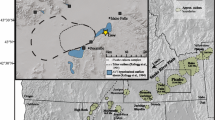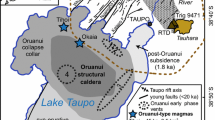Abstract
Large pyroclastic rhyolites are snapshots of evolving magma bodies, and preserved in their eruptive pyroclasts is a record of evolution up to the time of eruption. Here we focus on the conditions and processes in the Oruanui magma that erupted at 26.5 ka from Taupo Volcano, New Zealand. The 530 km3 (void-free) of material erupted in the Oruanui event is comparable in size to the Bishop Tuff in California, but differs in that rhyolitic pumice and glass compositions, although variable, did not change systematically with eruption order. We measured the concentrations of H2O, CO2 and major and trace elements in zoned phenocrysts and melt inclusions from individual pumice clasts covering the range from early to late erupted units. We also used cathodoluminescence imaging to infer growth histories of quartz phenocrysts. For quartz-hosted inclusions, we studied both fully enclosed melt inclusions and reentrants (connecting to host melt through a small opening). The textures and compositions of inclusions and phenocrysts reflect complex pre-eruptive processes of incomplete assimilation/partial melting, crystallization differentiation, magma mixing and gas saturation. ‘Restitic’ quartz occurs in seven of eight pumice clasts studied. Variations in dissolved H2O and CO2 in quartz-hosted melt inclusions reflect gas saturation in the Oruanui magma and crystallization depths of ∼3.5–7 km. Based on variations of dissolved H2O and CO2 in reentrants, the amount of exsolved gas at the beginning of eruption increased with depth, corresponding to decreasing density with depth. Pre-eruptive mixing of magma with varying gas content implies variations in magma bulk density that would have driven convective mixing.









Similar content being viewed by others
References
Anderson AT (1991) Hourglass inclusions—theory and application to the Bishop rhyolitic Tuff. Am Mineral 76:530–547
Anderson AT, Davis AM, Lu FQ (2000) Evolution of Bishop Tuff rhyolitic magma based on melt and magnetite inclusions and zoned phenocrysts. J Petrol 41:449–473
Arculus RJ, Belfield S-J, Earl KL (2005) Tracking development of the Taupo (New Zealand) rhyolitic magma chamber through melt inclusions. EOS Trans AGU 86(18), Jt Assem Suppl, Abstract V22A-03
Bacon CR (1989) Crystallization of accessory phases in magmas by local saturation adjacent to phenocrysts. Geochim Cosmochim Acta 53: 1055–1066
Behrens H, Tamic N, Holtz F (2004) Determination of molar absorption coefficient for the IR absorption band of CO2 in rhyolitic glasses. Am Mineral 89:301–306
Brown SJA, Fletcher IR (1999) SHRIMP U-Th dating of the preeruption growth history of zircons from the 340 ka Whakamaru Ignimbrite, New Zealand:evidence for >250 k.y. magma residence times. Geology 27: 1035–1038
Brown SJA, Wilson CJN, Cole JW, Wooden J (1998) The Whakamaru group ignimbrites, Taupo Volcanic Zone, New Zealand: evidence for reverse tapping of a zoned silicic magmatic system. J Volcanol Geotherm Res 84: 1–37
Charlier BLA, Davidson JP, Wilson CJN (2003) Generation processes in a high-silica rhyolite as recorded in plagioclase crystals from Taupo volcano, New Zealand. Geochim Cosmochim Acta 66(Suppl 15A):130
Charlier BLA, Wilson CJN, Lowenstern JB, Blake S, van Calsteren PW, Davidson JP (2005) Magma generation at a large, hyperactive silicic volcano (Taupo, New Zealand) revealed by U-Th and U-Pb systematics in zircons. J Petrol 46:3–32
Davy BW, Caldwell TG (1998) Gravity, magnetic and seismic surveys of the caldera complex, Lake Taupo, North Island, New Zealand. J Volcanol Geotherm Res 81:69–89
Dunbar NW, Hervig RL, Kyle PR (1989) Determination of pre-eruptive H2O, F and Cl contents of silicic magmas using melt inclusions: examples from Taupo volcanic center, New Zealand. Bull Volcanol 51: 177–184
Ewart A (1966) Review of mineralogy and chemistry of the acidic volcanic rocks of Taupo Volcanic Zone, New Zealand. Bull Volcanol 29:147–172
Ewart A, Griffin WL (1994) Application of proton microprobe data to trace element partitioning in volcanic rocks. Chem Geol 117:251–284
Götze J, Plötze M, Habermann D (2001) Origin, spectral characteristics and practical applications of the cathodoluminescence (CL) of quartz—a review. Mineral Petrol 71:225–250
Hervig RL, Dunbar N, Westrich HR, Kyle PR (1989) Pre-eruptive water-content of rhyolitic magmas as determined by ion microprobe analyses of melt inclusions in phenocrysts. J Volcanol Geotherm Res 36: 293–302
Hildreth W (1977) The magma chamber of the Bishop Tuff: gradients in temperature, pressure and composition. PhD Dissertation, University of California, Berkeley, 328 pp
Hildreth W (1979) The Bishop Tuff: Evidence for the origin of compositional zonation in silicic magma chambers. Geol Soc Am Spec Pap 180:43–75
Hildreth W (1981) Gradients in silicic magma chambers: implications for lithospheric magmatism. J Geophys Res 86:10153–10192
Holtz F, Johannes W, Tamic N, Behrens H (2001) Maximum and minimum water contents of granitic melts generated in the crust: a reevaluation and implications. Lithos 56:1–14
Liu Y, Zhang Y, Behrens H (2005) Solubility of H2O in rhyolitic melts at low pressures and a new empirical model for mixed H2O–CO2 solubility in rhyolitic melts. J Volcanol Geotherm Res 143:219–235
Lu FQ, Anderson AT, Davis AM (1995) Diffusional gradients at the crystal/melt interface and their effect on the composition of melt inclusions. J Geol 103:591–597
MacPherson GJ, Davis AM (1994) Refractory inclusions in the prototypical CM chondrite, Mighei. Geochim Cosmochim Acta 58:5599–5625
Nash WP, Crecraft HR (1985) Partition coefficients for trace-elements in silicic magmas. Geochim Cosmochim Acta 49:2309–2322
Newman S, Epstein S, Stolper EM (1988) Water, carbon dioxide, and hydrogen isotopes in glasses from the ca 1340 AD eruption of the Mono Craters, California: constraints on degassing phenomena and initial volatile content. J Volcanol Geotherm Res 35:75–96
Peppard BT, Steele IM, Davis AM, Wallace PJ, Anderson AT (2001) Zoned quartz phenocrysts from the rhyolitic Bishop Tuff. Am Mineral 86: 1034–1052
Skirius CM, Peterson JW, Anderson AT (1990) Homogenizing rhyolitic glass inclusions from the Bishop Tuff. Am Mineral 75:1381–1398
Smith RL (1979) Ash-flow magmatism. Geol Soc Am Spec Pap 180:5–27
Smith RL, Bailey RA (1966) The Bandelier Tuff; a study of ash-flow eruption cycles from zoned magma chambers. Bull Volcanol 29:83–103
Sutton AN, Blake S, Wilson CJN (1995) An outline geochemistry of rhyolite eruptives from Taupo Volcanic Center, New Zealand. J Volcanol Geotherm Res 68:153–175
Sutton AN, Blake S, Wilson CJN, Charlier BLA (2000) Late Quaternary evolution of a hyperactive rhyolite magmatic system: Taupo volcanic centre, New Zealand. J Geol Soc Lond 157:537–552
Wallace PJ, Anderson AT, Davis AM (1995) Quantification of pre-eruptive exsolved gas contents in silicic magmas. Nature 377:612–616
Wallace PJ, Anderson AT, Davis AM (1999) Gradients in H2O, CO2, and exsolved gas in a large-volume silicic magma system: interpreting the record preserved in melt inclusions from the bishop tuff. J Geophys Res 104:20097–20122
Wark DA, Watson EB (2004) The TITANiQ: a titanium-in-quartz thermometer. Geochim Cosmochim Acta 68 (Suppl):A543
Wilson CJN (1993) Stratigraphy, chronology, styles and dynamics of Late Quaternary eruptions from Taupo volcano, New Zealand. Phil Trans R Soc Lond A 343:205–306
Wilson CJN (2001) The 26.5 ka Oruanui eruption, New Zealand: an introduction and overview. J Volcanol Geotherm Res 112:133–174
Wilson CJN, Houghton BF, Lloyd EF (1986) Volcanic history and evolution of the Maroa-Taupo area, central North Island. In: Smith IEM (ed) Late Cenozoic volcanism in New Zealand. Royal Society of New Zealand Bulletin 23:194–223
Wilson CJN, Charlier BLA, Blake S, Sutton AN (2002) Pyroclastic deposits from ca 64 to 26.5 ka in the Maroa-Taupo area, New Zealand, reflect contemporaneous independent silicic magmatic systems. Eos, Trans Am Geophys Un 82 (22 suppl):Abstract SE 51B-01
Wilson CJN, Blake S, Charlier BLA, Sutton AN (2005) The 26.5 ka Oruanui eruption, Taupo volcano, New Zealand: development, characteristics and evacuation of a large rhyolitic magma body. J Petrol (in press)
Zhang YX, Behrens H (2000) H2O diffusion in rhyolitic melts and glasses. Chem Geol 169:243–262
Zhang YX, Belcher R, Ihinger PD, Wang LP, Xu ZJ, Newman S (1997) New calibration of infrared measurement of dissolved water in rhyolitic glasses. Geochim Cosmochim Acta 61:3089–3100
Acknowledgements
This work was supported by US NSF grants EAR 0106327 and 0408707, Marsden Fund grant GNS 202 from the Royal Society of New Zealand, and the New Zealand Foundation for Research, Science & Technology. Thorough and thoughtful reviews by Tom Vogel, Tim Grove, and Charlie Bacon are appreciated. We also thank Youxue Zhang for his generosity in allowing us access to the FTIR spectrometer at the University of Michigan.
Author information
Authors and Affiliations
Corresponding author
Additional information
Communicated by: T. L. Grove
Electronic supplementary material
Rights and permissions
About this article
Cite this article
Liu, Y., Anderson, A.T., Wilson, C.J.N. et al. Mixing and differentiation in the Oruanui rhyolitic magma, Taupo, New Zealand: evidence from volatiles and trace elements in melt inclusions. Contrib Mineral Petrol 151, 71–87 (2006). https://doi.org/10.1007/s00410-005-0046-3
Received:
Accepted:
Published:
Issue Date:
DOI: https://doi.org/10.1007/s00410-005-0046-3




